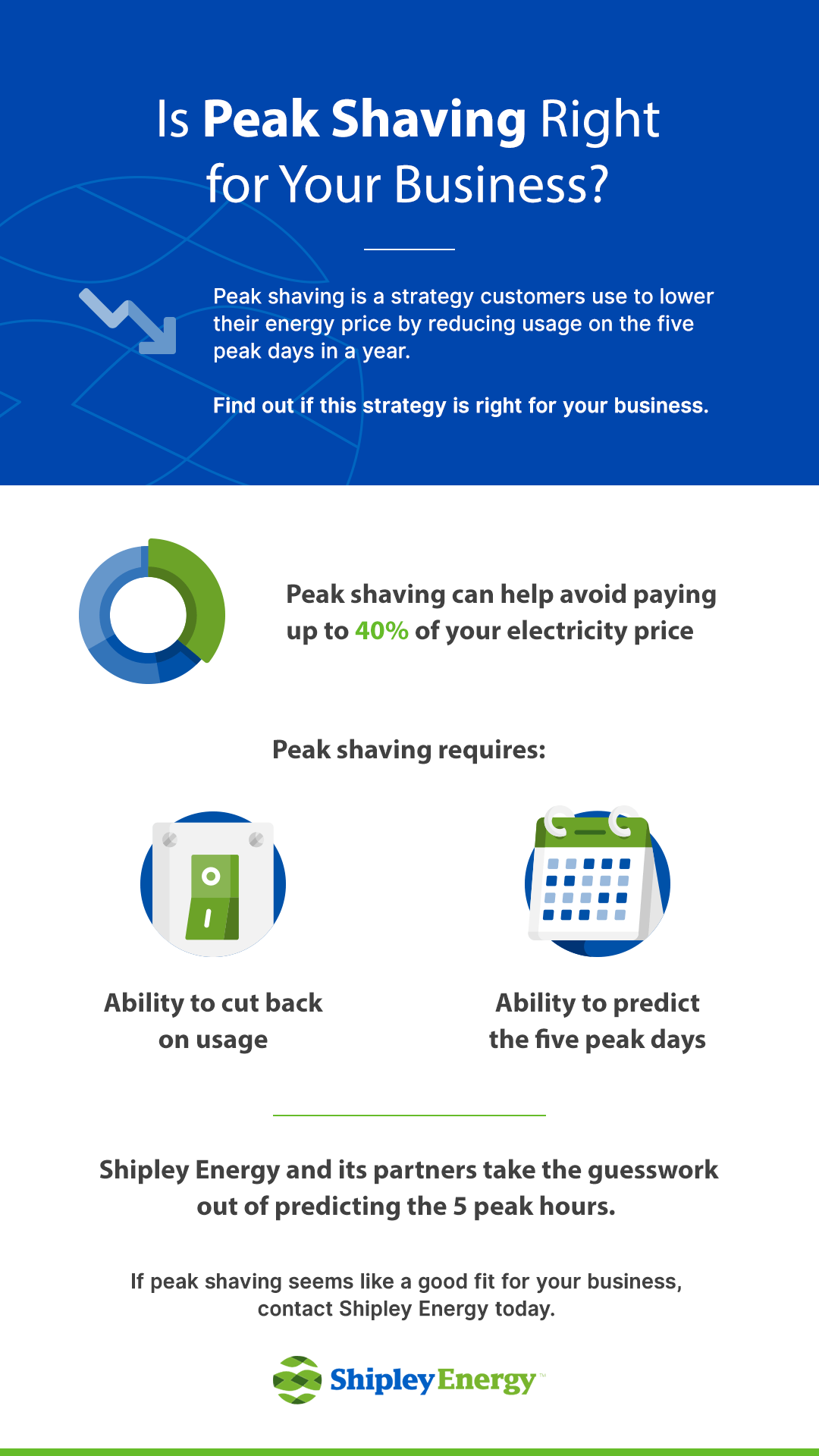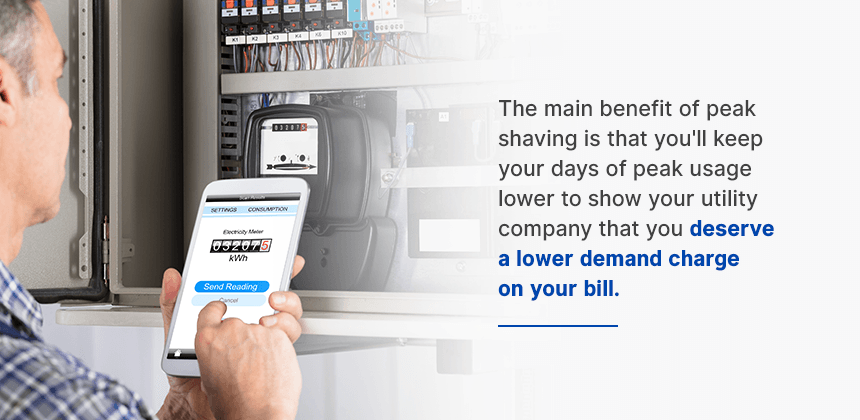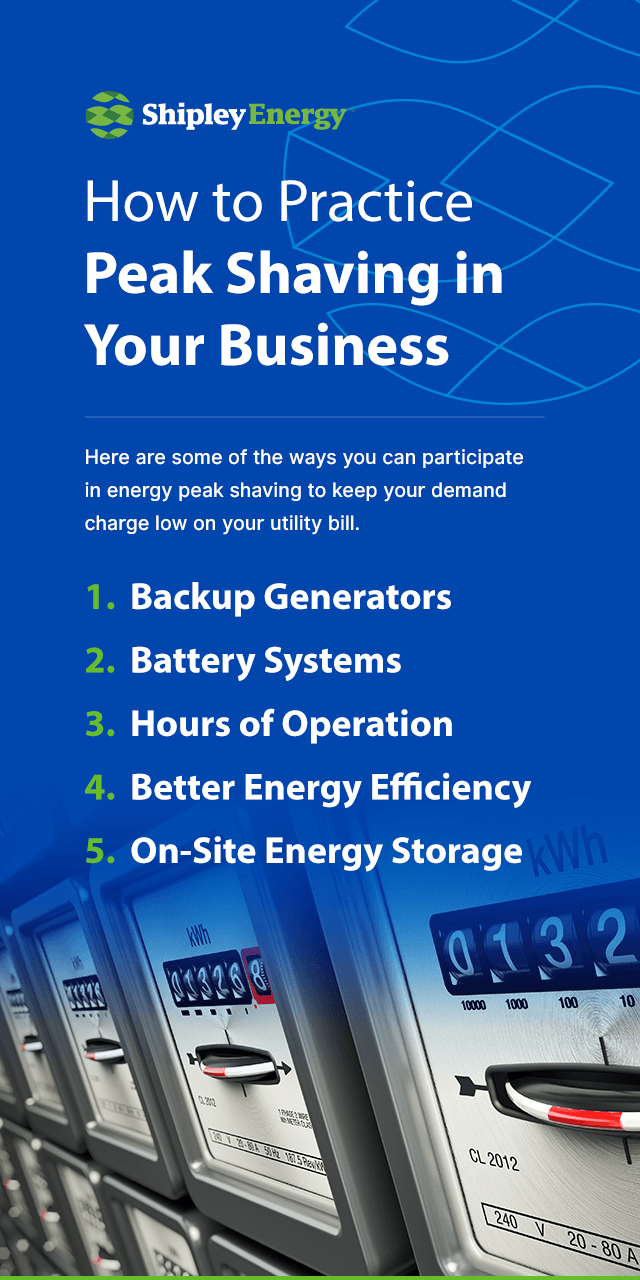

Energy is at the center of every business. You need it to perform your daily functions, serve your customers, and turn a profit. One of the most important sources of energy today is electricity, and while you’re willing to pay what it takes to run your business, you still want to save money where you can.
Many businesses are unaware they can be saving money by being smarter about how and when they use electricity. You have the ability to lower your energy bill, but you’ll need to know more about how your energy provider charges you to understand how you can cut costs. More goes into your energy bill than straight consumption costs alone. Take a closer look at your energy bill and discover the practice you can use to enjoy lower payments — peak shaving.
Peak shaving is a strategy businesses use to lower their energy price by reducing usage on the five peak days in a year used to determine capacity and transmission tags. These factors can determine nearly 40% of your electricity price. But, if you’re strategic about it, you can avoid a higher capacity and transmission tag and lower your bills for the future.
In peak shaving, you have the opportunity to lower your usage during several “peak” days of the year that will determine your capacity and transmission payments. Reducing the amount of energy you use on these days will give your energy provider a different reading on your company, thus giving you a lower capacity and transmission payment.
Why do a few days of peak usage cause your utility bill to rise to such an extent? Your energy provider is supplying energy to other businesses, too, and they need to make sure they have enough to go around. If your business demands more energy, you’ll have to pay for it.
Think of it as a parking lot. All year long, a business may get a certain number of customers. But on peak days like holidays or weekends, that company may see a lot more customer traffic they’ll have to accommodate. They would need to build a parking lot big enough for all their customers’ cars on the busiest days, even if most of the spots remained empty on normal days. Electrical energy consumption functions much the same way.
Peak shaving works by throttling your electrical energy consumption on peak days. Companies can significantly lower their electricity bills if they’re able to cut back by scaling back operations or turning on a generator on the five peak days.

Enter your contact details, and we’ll look forward to helping you achieve successful commercial peak shaving!
There are two types of charges you’ll receive from your utility company — consumption charges and demand charges. The combination of these charges makes up your entire electrical energy bill. Here’s how they differ:
Your utility company determines your consumption charges by kilowatt-hours (kWh). In other words, this part of your bill reflects how much energy you actually used in a billing cycle. Here are the three types of consumption charges you could experience based on your contract with your electricity supplier:
Every company’s electricity bill has two parts — the consumption charges and the demand charges. Having a better understanding of demand charges is what will help you make the most of your peak shaving.
With demand charge billing, you pay for the highest power load that your business consumes. This is the peak demand, which is the highest average load during a peak demand interval — which could be around 15 minutes — in a single billing cycle. Your utility company calculates the demand charge of your bill by multiplying this peak demand rate by the peak demand fee. So if the demand fee is $10 per kW, and you hit a peak load of 150 kW, you’ll be paying a demand charge of $1,500.
To return to our parking analogy, even a business that only has a few busy days per year needs to make sure they have enough parking spots for their customers on those days. Failing to have enough parking spots can result in a loss of business. Likewise, if you’re unable to access the electricity you need to function, you’ll be left out to dry and experience energy shortages, causing your production to come to a halt.
If your business only uses a small amount of electricity at its peak, then you’ll have low demand charges. But if you rely on a lot of electricity to carry out your functions, you’ll have higher demand charges and a higher monthly bill. Even if you only use a large amount of electricity five times per year, that’s enough to tell your utility company that you need to pay more to get those high levels of electricity when you need them.
At face value, many businesses think these demand charges are worth getting the amount of electricity they need during their peak demand interval. Others want to cut their costs, figuring these short bursts of high energy usage shouldn’t determine a higher billing statement. If this sounds like you, then you may want to consider peak shaving.
The main benefit of peak shaving is that you’ll keep your days of peak usage lower to show your utility company that you deserve a lower demand charge on your bill. There are many ways to accomplish peak shaving, but each method is after the same goal — showing your utility company you don’t need higher amounts of electricity that lead to a higher monthly payment.

Here are some of the ways you can participate in energy peak shaving to keep your demand charge low on your utility bill.

One common way to practice peak shaving is with backup generators. Keep your generators ready so that when moments of peak electrical usage come, you can rely on them as an alternate source of power. This will take the top off your electricity usage so your utility company can keep your demand charge as low as possible.
Make sure to keep your backup generators in working order so they’re ready for you to use at a moment’s notice. The last thing you want is for your time of peak usage to come and not have a working generator available to cut your peak.
Battery systems are like backup generators in that they offer an alternate source of power. One major benefit of a battery-powered system is that you can have the batteries charging when not in use. That way you’re sure to have energy the moment you need it.
You can even program your battery-powered system to turn on the moment your electricity usage reaches a certain level. This allows you to focus more on your tasks at hand and less on wondering if your energy use is going to start peaking. Your batteries can handle the top end of your electricity use so the rest of your systems operate like normal, keeping your demand costs down.
Another commercial demand response for electrical use is to change your hours of operation. This solution can be difficult, as its benefits are obvious, but it’s not always practical. The simple fact is that if you’re operating at off-peak hours, your demand charge could be lower because you’re not fighting with as many other businesses for your needed electricity.
Unfortunately, you may be unable to change your company’s hours of operations to cut back on your demand charges. Your employees may be unwilling to change their shifts, or your product or service may require operating during on-peak hours for success. Consider your ability to shift some of your operations to off-peak hours, and this can help lower your consumption charges and even your demand charges. In some situations, businesses can even get paid for curbing their energy usage!
Another demand response for businesses is to seek better energy efficiency. If you can track your energy usage over time, you can see where and when you use the most energy to help you determine how to cut back. In some cases, you can even get the help of a professional for insight into how you can save on energy. Here are a few ways you can make your business more energy-efficient:
You can also cut back on your energy usage during peak moments by tapping into a reserve source of energy on your business property. If your business has the cubic feet to spare, you can install a tank, holding area, or battery system room to give an on-site energy supply.
This gives you the energy independence to use your on-site fuel source to power your machinery when the grid goes down. Or, you can use your reserve supply of energy to cut back when you know you’re reaching peak usage levels. If you can determine what days or times you use the most energy, you can make the most of your alternative fuel source to cut back on your electrical demand.
To have success with peak shaving, you need to be willing and able to cut back on energy when necessary. You also need to be able to identify your company’s moments of peak energy use.
How you cut back on your demand usage is up to your company, but you don’t have to guess the five peak days alone. There are companies that work with customers to help them predict the peak days in their utility and notify them to drop usage at that time. They typically work on a shared savings basis which means the risk to the business is very low.
Shipley Energy and its partners can predict the peak energy usage days with impressive accuracy, help you successfully peak shave electricity, and empower you to avoid paying more than you have to on your energy bill.
If you’d like to learn more, contact Shipley Energy today. We offer educational resources online to help you learn how to make the most of your energy, and we’re always willing to talk over the phone to address your unique energy situation. We look forward to helping you achieve successful commercial peak shaving!
